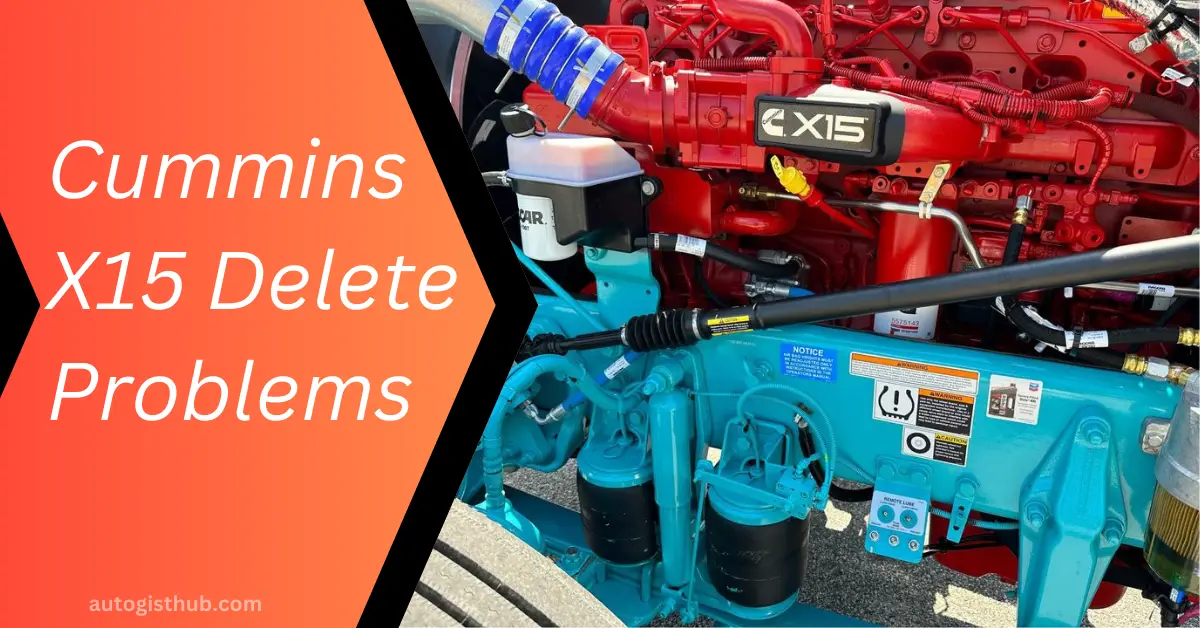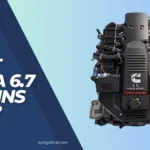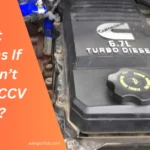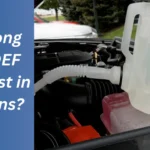Cummins X15 delete problems can cause various issues and should be addressed promptly to avoid further complications. When you encounter problems with Cummins X15 delete, it is essential to take immediate action to prevent any potential damage or prolonged downtime.
Introducing Cummins X15 delete problems: Cummins X15 delete problems can be a cause for concern and need to be treated as such. As the owner or operator of a Cummins X15 engine, it is vital to be aware of these potential issues and know how to address them effectively.
By having a clear understanding of these issues and knowing the appropriate steps to take, you can ensure the smooth operation of your Cummins X15 engine and avoid any unnecessary downtime. So, let’s delve into the world of Cummins X15 delete problems and their solutions.
Expert Opinions and Case Studies
When it comes to understanding the challenges and benefits of Cummins X15 deletes, nothing beats hearing from industry experts and examining real-world case studies. In this section, we will delve into insights from experts and present you with noteworthy case studies that shed light on the experiences of individuals who have undertaken Cummins X15 deletes.
By exploring these expert opinions and case studies, we can gain a deeper understanding of the problems that may arise during the process and the lessons we can learn from successful deletes.
Insights from Industry Experts on Cummins X15 Deletes
Cummins X15 deletes are a complex process that require meticulous planning and execution. Industry experts who specialize in diesel engine modifications have valuable insights that can help us navigate the challenges of Cummins X15 deletes. Here are a few key opinions shared by these knowledgeable professionals:
- Removing the emissions systems in the X15 engine can improve fuel economy and enhance performance, but it is essential to ensure compliance with local regulations and emission standards. The expertise of experienced professionals is crucial in navigating these legal and technical complexities.
- It is important to carefully weigh the potential benefits against the risks and costs associated with Cummins X15 deletes. Expert advice can help you make an informed decision based on your specific requirements and circumstances.
- The tuning and calibration of the engine after deletion are critical to optimizing performance while maintaining reliability. Relying on industry experts who have hands-on experience with Cummins X15 deletes greatly reduces the risk of encountering technical issues during and after the process.
Real-world Case Studies of Cummins X15 Delete Experiences
Real-world case studies provide valuable insights into the actual experiences of individuals who have gone through the Cummins X15 delete process. Here are a few examples that highlight different aspects of the delete journey:
| Case Study | Key Takeaways |
|---|---|
| Trucking company XYZ | – Improved fuel efficiency by 10% through proper engine calibration – Faced initial challenges in meeting local emission standards, but resolved them with expert guidance – Reduced maintenance costs due to the simplified emissions system |
| Owner-operator John Doe | – Experienced significant power gains after deleting emissions systems – Encountered unforeseen compatibility issues with aftermarket components – Appreciated the support and troubleshooting assistance provided by a certified Cummins X15 delete provider |
Lessons Learned and Best Practices for Successful Deletes
Through the combination of expert opinions and real-world case studies, we can distill valuable lessons and best practices for anyone considering Cummins X15 deletes. Some key takeaways include:
- Engage with experienced professionals who possess in-depth knowledge of the local emission regulations and can guide you through the compliance process.
- Invest in proper tuning and calibration to optimize performance and mitigate any potential issues.
- Research and select reputable providers who offer reliable support and assistance before, during, and after the delete process.
- Evaluate the cost-benefit ratio and consider the long-term implications of the delete, taking into account factors such as fuel efficiency, maintenance costs, and legal compliance.
Cummins X15 Delete Vs Emission Laws
The Cummins X15 engine is known for its power and performance, but it also comes with strict emissions regulations. As a result, some truck owners may consider opting for a Cummins X15 delete, which involves removing or modifying certain components of the engine to improve performance or bypass emission restrictions.
However, it’s important to understand the difference between deletes and emission laws, as well as the legalities, risks, and penalties associated with non-compliant deletes in various regions.
Understanding the Difference Between Deletes and Emission Laws
Determining the difference between Cummins X15 deletes and emission laws is crucial to making informed decisions as a truck owner. Deletes essentially involve modifying the engine’s system to disable or bypass emission control devices, allowing for improved performance at the cost of increased emissions.
On the other hand, emission laws are in place to regulate and minimize pollutant emissions from vehicles to protect the environment and public health. It’s important to note that most countries, including the United States, have stringent emission standards that must be met by diesel engines like the Cummins X15.
These standards are set by government regulatory bodies such as the Environmental Protection Agency (EPA) in the US and are enforced through emissions testing and compliance checks.
The Legalities of Cummins X15 Deletes in Various Regions
The legalities surrounding Cummins X15 deletes vary by region. For example, in the United States, tampering with emission control systems is strictly prohibited by federal law. This means that performing a delete on your Cummins X15 engine without proper authorization is illegal and can result in significant fines and penalties.
In some countries or states, there may be specific regulations or requirements that allow for certain modifications or deletes under certain circumstances. However, it’s critical to research and understand the regulations applicable to your region before considering a Cummins X15 delete.
Risks and Penalties Associated with Non-compliant Deletes
Engaging in non-compliant Cummins X15 deletes can expose truck owners to a variety of risks and penalties. Firstly, a non-compliant delete can lead to increased emissions, which not only harm the environment but can also result in failed emissions tests and inspections. This can lead to fines, vehicle impoundment, or even the inability to legally operate the truck on public roads.
Furthermore, tampering with emission control systems can void warranties or extended coverage plans provided by the engine manufacturer or the vehicle’s warranty provider. This means that any repairs or replacements needed due to engine issues may become the truck owner’s sole responsibility.
It’s also essential to consider the reputation and trustworthiness of the service provider performing the delete. Using an uncertified or inexperienced technician for the delete can lead to improper modifications, potential damages to the engine, and even safety hazards.
Ultimately, truck owners should weigh the risks, penalties, and legal ramifications before opting for a Cummins X15 delete. It is crucial to prioritize compliance with emission laws to protect the environment, avoid penalties, and maintain the integrity of the vehicle’s warranty and performance.
Keeping Cummins X15 Engine Compliant
Are you a proud owner of a Cummins X15 engine but worried about compliance with emission laws? Keeping Cummins X15 Engine Compliant is essential to ensure your engine’s longevity and avoid legal trouble.
In this section, we will explore recommended maintenance and care practices for a compliant engine, available alternatives to deletes for improving performance, and how to ensure long-term reliability while complying with emission laws.
Recommended Maintenance and Care Practices for a Compliant Engine
Proper maintenance and care not only keep your Cummins X15 engine running smoothly but also help it stay compliant with emission laws. Here are some maintenance practices that you should follow:
- Regularly check and replace air filters to prevent dirt and debris from entering the engine, which can negatively impact performance and emissions.
- Ensure timely oil changes according to the manufacturer’s recommendations to maintain optimum engine lubrication and reduce harmful emissions.
- Keep an eye on fuel filters and replace them as needed to prevent contaminants from reaching the engine, which can affect efficiency and emissions.
- Regularly inspect and maintain the exhaust system, including the Diesel Particulate Filter (DPF) and Selective Catalytic Reduction (SCR) components, to ensure they are functioning correctly.
- Follow Cummins’ recommended service intervals for maintenance tasks such as valve adjustments, coolant changes, and fuel system inspections.
- Utilize Cummins’ advanced engine monitoring systems to detect any potential issues early on and address them promptly.
Available Alternatives to Deletes for Improving Performance
If you’re looking to improve your Cummins X15 engine’s performance without resorting to deletes, there are alternatives available:
- Consider upgrading to a higher-performance ECM (Engine Control Module) that allows for tuning modifications while maintaining compliance with emission regulations.
- Explore options for performance-enhancing aftermarket parts, such as high-flow air intake systems, exhaust upgrades, and performance tuners calibrated for compliance.
- Collaborate with certified Cummins service providers who specialize in performance modifications while keeping your engine compliant.
Ensuring Long-term Reliability While Complying with Emission Laws
When it comes to ensuring the long-term reliability of your Cummins X15 engine while complying with emission laws, a balanced approach is crucial. Here are some key aspects to consider:
- Partner with a Cummins-certified service provider who understands the intricacies of maintaining compliance while maximizing performance.
- Regularly monitor your engine’s emissions using Cummins’ recommended diagnostic tools and perform necessary adjustments or repairs as needed.
- Maintain a detailed record of all maintenance and servicing, including parts replacements and adjustments, for future reference and compliance documentation.
- Stay updated on the latest emission regulations and incorporate any necessary updates or modifications to your engine to ensure ongoing compliance.
- Engage in proactive training and education about emission control systems to better understand how they function and how to optimize their performance.
By following these recommended maintenance practices, exploring alternative performance enhancement options, and prioritizing compliance, you can keep your Cummins X15 engine running smoothly, reliably, and compliant with emission laws.
Selecting a Cummins X15 Delete Solution
The Cummins X15 engine is a powerful and reliable option for heavy-duty trucks and commercial vehicles. However, if you’re experiencing problems with your Cummins X15 engine and considering a delete solution, it’s essential to choose the right option.
Selecting a Cummins X15 delete solution requires careful evaluation of factors such as reliability, performance, and customer feedback. In this article, we will discuss the essential factors to consider when choosing a delete solution for your Cummins X15 engine and review the available delete options in the market.
Factors to Consider When Choosing a Delete Solution
When selecting a delete solution for your Cummins X15 engine, it’s crucial to keep a few key factors in mind:
- Compatibility: Ensure that the delete solution you choose is compatible with your specific Cummins X15 engine model. Not all delete options may be suitable for all engine versions, so double-check the compatibility before making a decision.
- Legal compliance: Compliance with local emission laws and regulations is vital. Make sure the delete solution you choose is compliant with the emissions standards in your region.
- Reliability: You want a delete solution that provides long-lasting reliability. Look for options that have a proven track record of durability and performance.
- Warranty: Check if the delete solution comes with a warranty. A warranty can provide peace of mind and coverage for any unexpected issues that may arise.
- Installation process: Consider the complexity and ease of installation. Look for options that offer clear instructions and provide support if needed.
Reviewing Available Delete Options in the Market
Now, let’s take a closer look at some of the delete options available in the market for Cummins X15 engines:
Delete Option 1: Manufacturer-Approved Solutions
Some engine manufacturers offer their own approved delete solutions, specifically designed to address common issues in their engines. These solutions often come with warranties and provide compatibility assurance. However, they can be more expensive compared to other options.
Delete Option 2: Aftermarket Delete Kits
Aftermarket delete kits are produced by third-party manufacturers and can offer cost-effective alternatives. However, it’s essential to research and choose a reputable brand that has a reputation for reliability and customer satisfaction. Look for positive customer feedback and reviews before making your decision.
Delete Option 3: Custom Delete Solutions
For those looking for more specialized solutions, custom delete options may be available. These solutions are tailored to specific needs and requirements, but they may require more research and expertise to ensure compatibility and proper installation.
Evaluating Reliability, Performance, and Customer Feedback
When choosing a Cummins X15 delete solution, it’s crucial to evaluate the reliability, performance, and customer feedback associated with each option. Look for:
- Delete solutions with a proven track record of reliability and durability.
- Performance enhancements that meet your specific needs, such as increased fuel efficiency or power.
- Customer reviews and feedback that highlight positive experiences and satisfaction with the delete solution.
By considering these factors and thoroughly researching the available delete options, you can select a Cummins X15 delete solution that addresses your engine problems effectively and ensures optimal performance.
Common Problems with Cummins X15 Deletes
If you own a Cummins X15 engine, you may have come across the concept of delete kits for emission systems. While deleting certain emission systems from your Cummins X15 engine may offer benefits such as improved fuel efficiency and performance, it also comes with its fair share of problems.
In this article, we will explore the common problems associated with Cummins X15 deletes, including their impact on engine performance and reliability, potential consequences of deleting emission systems, and the warranty and insurance implications.
The Impact of Cummins X15 Deletes on Engine Performance and Reliability
Deleting certain emission systems from your Cummins X15 engine can have a significant impact on its performance and reliability. While it is true that delete kits can improve fuel efficiency and increase horsepower, it is essential to consider the long-term effects. Removing emission systems can lead to higher exhaust temperatures, increased stress on engine components, and diminished reliability.
The engine may experience excessive wear and tear, resulting in a shorter lifespan and costly repairs. It is crucial to weigh the benefits against these potential drawbacks before deciding to delete any emission system.
Potential Consequences of Deleting Emission Systems
When you remove emission systems from your Cummins X15 engine, you might be opening the door to a host of potential consequences. One significant consequence is the violation of emissions regulations. Deleting emission systems can put you at odds with local, state, or federal laws, potentially resulting in fines or penalties.
Moreover, it may also void the engine’s warranty, leaving you responsible for any repairs or replacements. Additionally, deleting emission systems can negatively impact the environment by releasing harmful pollutants into the air, contributing to air pollution and diminishing air quality for everyone.
Warranty and Insurance Implications for Cummins X15 Deletes
Before proceeding with any Cummins X15 delete, it is essential to understand the warranty and insurance implications. Deleting emission systems can void the engine’s warranty, meaning that any future repairs or replacements will be solely at your expense.
It is crucial to consider the potential costs and consequences before making a decision. Moreover, insurance companies may also refuse coverage or charge higher premiums for vehicles with deleted emission systems, as these modifications can be seen as increasing the risk of engine failure or environmental damage.
In conclusion, while Cummins X15 deletes may offer short-term benefits, it is crucial to consider the common problems associated with them. The impact on engine performance and reliability, potential consequences in terms of emissions regulations and environmental impact, as well as warranty and insurance implications, are all significant factors that should be carefully weighed before deciding to delete any emission system from your Cummins X15 engine.
Effect on Fuel Efficiency and Power Output
Fuel efficiency and power output are two crucial factors that every truck owner considers when making modifications to their Cummins X15 engine. In this section, we will explore the impact of Cummins X15 deletes on fuel efficiency and power output, and how truck owners can strike a balance between performance gains and fuel efficiency.
How Cummins X15 Deletes Can Impact Fuel Efficiency
When a Cummins X15 engine undergoes a delete, certain emissions control systems, such as the exhaust gas recirculation (EGR) system and diesel particulate filter (DPF), are removed or disabled. While these systems play a vital role in reducing emissions, they can also have an impact on fuel efficiency.
By removing or disabling the EGR system, which recirculates a portion of exhaust gases back into the engine, the intake air temperature is reduced, resulting in a cooler intake charge. This cooler intake charge can improve combustion efficiency and subsequently increase fuel efficiency.
Moreover, without the DPF, the exhaust flow is less restricted, allowing the engine to breathe more freely. This improved airflow can lead to better fuel combustion and ultimately, improved fuel efficiency.
Potential Gains in Power Output From a Delete
Alongside the potential for improved fuel efficiency, Cummins X15 deletes can also offer gains in power output. By removing or disabling emissions control systems, the engine can operate with fewer restrictions, allowing for increased airflow and reduced exhaust backpressure. These factors can result in increased power and torque.
Additionally, removing or disabling the EGR system can prevent the recirculation of hot exhaust gases into the engine, reducing the risk of engine knock and increasing the potential for higher power output.
| Performance Area | Potential Gains |
|---|---|
| Fuel efficiency | Better combustion efficiency and improved airflow |
| Power output | Increased airflow, reduced backpressure, and lower risk of engine knock |
Balancing Performance Gains with Fuel Efficiency
While Cummins X15 deletes can lead to notable improvements in power output, it is important to strike a balance between performance gains and fuel efficiency. It is advisable to consult with experienced professionals and consider your specific needs before making any modifications.
Moreover, optimizing fuel efficiency involves more than just deletes. Additional enhancements, such as engine tuning, proper maintenance, and driving habits, play a crucial role in maximizing fuel efficiency while still enjoying the benefits of increased power output. Taking a holistic approach is key to achieving the desired balance.
Understanding Cummins X15 Emission Deletes
Are you familiar with the Cummins X15 engine? This powerful and reliable engine is known for its excellent performance and efficiency. However, like any other modern engine, it is equipped with emission control systems to comply with environmental regulations. But what if you’ve heard about something called a Cummins X15 delete?
In this section, we will dive deeper into the topic of Cummins X15 emission deletes, discussing the overview of the Cummins X15 engine and its emission control systems, what exactly a Cummins X15 delete is and why it is done, and the legal implications and regulations surrounding Cummins X15 deletes.
Overview of Cummins X15 Engine and Its Emission Control Systems
The Cummins X15 engine is a heavy-duty diesel engine that is widely used in various applications such as trucks, buses, and industrial equipment. It is renowned for its exceptional power, fuel efficiency, and durability, making it a favorite choice among many operators.
To meet the stringent emission regulations set by government authorities, Cummins has equipped the X15 engine with advanced emission control systems. These systems are designed to reduce harmful pollutants, such as nitrogen oxide (NOx) and particulate matters (PM), emitted by the engine.
The key components of the Cummins X15 emission control systems include:
- Exhaust Gas Recirculation (EGR) system: This system recirculates a portion of the exhaust gases back into the combustion chamber to reduce the formation of NOx.
- Selective Catalytic Reduction (SCR) system: The SCR system injects a urea-based diesel exhaust fluid (DEF) into the exhaust stream, which reacts with the NOx to convert it into harmless nitrogen and water vapor.
- Diesel Particulate Filter (DPF): The DPF captures and stores the particulate matters present in the exhaust stream. Periodically, the trapped particles are burned off through a process called regeneration.
What is a Cummins X15 Delete and Why is it Done?
A Cummins X15 delete, also known as an emission delete or emission modification, refers to the process of removing or bypassing some or all of the emission control systems installed on the engine. This can involve disabling the EGR system, removing the DPF and SCR systems, or both.
There are several reasons why operators may choose to perform a Cummins X15 delete. Some of these reasons include:
- Improved engine performance: By deleting the emission control systems, some operators claim to experience increased engine power, better throttle response, and improved fuel efficiency.
- Reduced maintenance costs: The emission control systems, particularly the DPF, require regular maintenance and may need replacement over time. Deleting these systems can eliminate the associated maintenance costs.
- Extended engine life: Some operators believe that by removing the emission control systems, they can reduce the wear and tear on the engine, potentially extending its lifespan.
- Preference for older technology: Some operators prefer the older engines that did not have stringent emission control systems, considering them more straightforward and easier to maintain.
Legal Implications and Regulations Surrounding Cummins X15 Deletes
Performing a Cummins X15 delete raises important legal considerations. It is essential to understand that tampering with the emission control systems is generally not in compliance with environmental regulations.
The Clean Air Act and various local laws prohibit the removal or modification of emission control systems on vehicles and engines. Violations of these regulations can result in substantial fines and penalties.
Furthermore, it is important to note that performing a Cummins X15 delete can also void the engine warranty provided by Cummins or the vehicle manufacturer. Operators considering a delete should carefully weigh the potential benefits against the legal and warranty implications.
FAQs for Cummins X15 Delete Problems
A Cummins X15 engine typically lasts for about 1 million miles, providing long-lasting performance and durability.
The difference between Cummins X15 and ISX15 is that the X15 is the newer generation engine, offering improved fuel efficiency and lower emissions. The ISX15, on the other hand, is the previous model. The X15 is designed to meet the latest emissions standards, making it a more advanced option.
Yes, the Cummins X15 is a reliable engine. It has proven durability and performance in various applications. With advanced technology and a reputation for reliability, the Cummins X15 provides dependable performance for a wide range of heavy-duty vehicles.
Conclusion
To sum up, the Cummins X15 delete problems can be frustrating for truck owners. The potential risks and negative impacts on engine performance make it crucial to approach modifications with caution. It’s essential to consult with knowledgeable professionals and consider the long-term consequences before making any decisions.
Ultimately, prioritizing maintenance and following manufacturer guidelines can help avoid complications and ensure the longevity of the engine.




